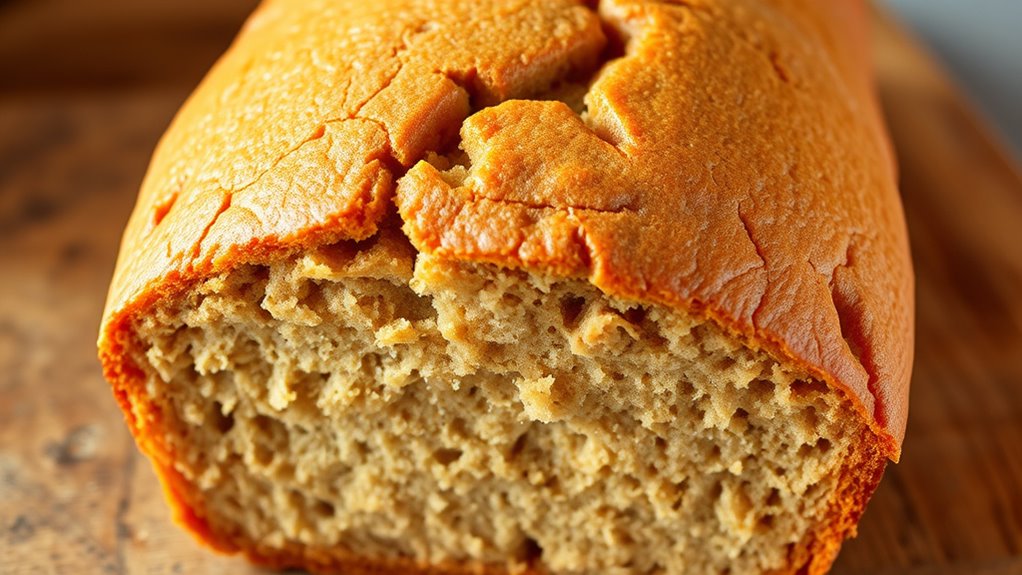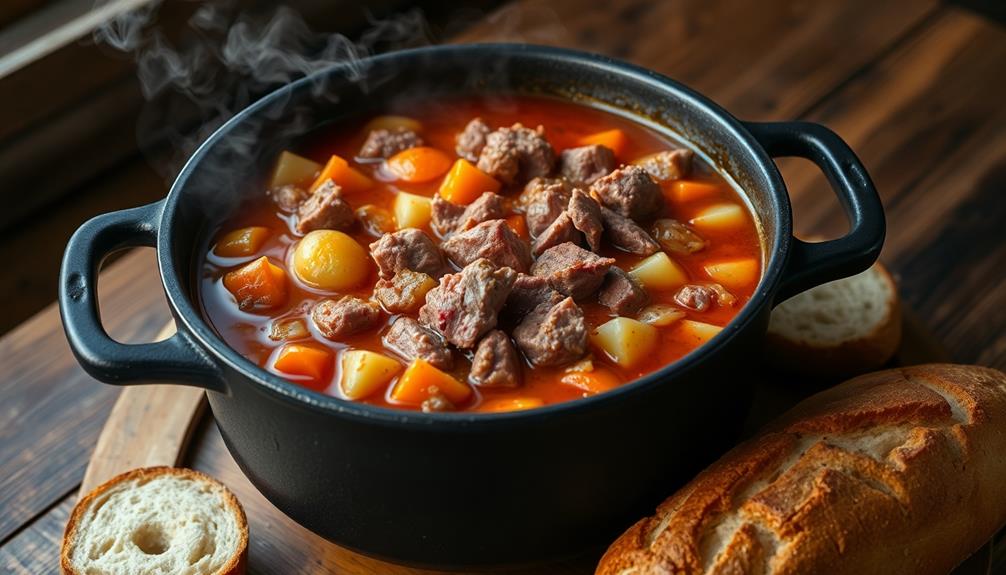If your banana bread sinks, it’s likely due to poor gas retention during baking. Overmixing can rupture bubbles, while undermixing prevents proper leavening agent distribution. Temperature issues also matter—if your oven is too cool or uneven, the bread won’t rise enough or may collapse. Ensuring the right mixing technique, accurate oven temperature, and proper baking process helps trap the gases needed for a good rise. Keep going to uncover more ways to perfect your loaf.
Key Takeaways
- Overmixing batter ruptures bubbles, reducing gas retention and causing the bread to sink after baking.
- Using incorrect oven temperature prevents proper rising and can lead to collapse.
- Insufficient preheating or uneven heat distribution weakens the loaf’s ability to maintain structure.
- Inadequate or improperly mixed leavening agents fail to produce enough carbon dioxide for proper lift.
- Not handling batter gently or overmixing can break gas bubbles, resulting in poor gas retention and a sunken loaf.

Have you ever baked banana bread only to find it sinking in the middle? It’s frustrating to see a loaf that looks perfect on the outside but collapses once you cut into it. The culprit often comes down to how the batter was prepared or how the oven was set. When your batter is overmixed, it can cause the bread to sink. Mixing the batter too vigorously develops gluten in the flour, making the loaf dense and prone to collapsing as it cools. You want just enough mixing to combine the ingredients without overdoing it. Stirring until just combined is usually best—stop as soon as you see no more dry flour. This helps maintain a light, tender crumb and prevents excess gluten development that can trap air bubbles and weaken the structure.
Another common reason for a sunken banana bread is an incorrect oven temperature. If your oven runs too hot or too cold, it throws off the leavening process. When the oven is too hot, the outside of the bread sets quickly, trapping gases inside. But if the heat isn’t maintained or is uneven, the gases escape before the bread has fully baked, causing it to collapse. Conversely, if your oven is too cool, the bread won’t rise properly, and the leavening gases won’t expand enough to lift the batter. Always use an oven thermometer to check your oven’s actual temperature. Preheating thoroughly ensures the oven reaches the right heat before baking begins, helping the bread rise evenly and retain its shape. Proper heat distribution is essential for consistent baking results. Additionally, understanding how leavening agents work can help you adjust your recipe for better rise and structure.
Leavening gas retention plays a vital role here. When you mix your batter, you incorporate air and leavening agents like baking soda or baking powder. These produce carbon dioxide, which creates bubbles that help the bread rise. If the batter is overmixed, the bubbles can rupture or escape, reducing the bread’s ability to hold onto those gases during baking. Without enough retained gas, the structure isn’t strong enough to support the loaf as it cools, leading to sinking. The key is to mix just enough to evenly distribute the leavening agents and bananas without breaking down the bubbles that give your bread its lift. Using an accurate oven thermometer can help ensure consistent baking temperatures, which is crucial for proper gas retention.
Frequently Asked Questions
Can Adding More Baking Soda Prevent Banana Bread From Sinking?
Adding more baking soda might seem like a fix, but it can actually cause issues. Baking soda chemistry shows that too much releases excess gas quickly, leading to weak gas entrapment and sinking. To prevent this, focus on proper gas entrapment techniques, like gentle mixing and accurate measurements. Using the right amount of baking soda guarantees the leavening gases stay trapped longer, giving your banana bread a better rise and preventing it from sinking.
How Does Overmixing Batter Affect Gas Retention?
Think of your batter like a balloon; overmixing is like overinflating it, causing it to pop. When you overmix, you develop too much gluten, making the batter tough and preventing gas from staying trapped. This reduces the leavening gas retention, leading to a dense, sunken bread. Use a gentle mixing method to keep gluten development minimal, ensuring your banana bread rises beautifully instead of sinking.
Does Altitude Influence Banana Bread Sinking?
Altitude effects can cause your banana bread to sink because lower air pressure affects leavening. At higher altitudes, gases expand faster and escape more easily, making it tricky to retain enough leavening. To counter this, you should make baking adjustments like reducing leavening agents and increasing liquid. These changes help your bread hold its structure and prevent sinking, ensuring better results at different altitudes.
What Role Does Oven Temperature Play in Gas Retention?
You might think oven heat is just for setting the baked goods’ doneness, but it actually controls how well your banana bread retains gas. Too high a temperature, and the outside burns before the center sets, releasing leavening gases prematurely. Proper temperature control guarantees the heat is just right, helping your bread hold its rise and preventing that undesired sinking sensation. Ironically, the right oven heat keeps your loaf airy and perfect.
Are There Specific Ingredients That Improve Gas Retention?
Certain ingredients can improve gas retention in your banana bread by enhancing ingredient stability and facilitating beneficial chemical interactions. Using fresh baking soda or baking powder ensures reliable leavening, while adding a small amount of acid, like yogurt or buttermilk, helps activate leavening agents effectively. These ingredients work together to create a stable environment for gas retention, leading to a lighter, fluffier loaf. Always measure accurately to optimize these chemical interactions.
Conclusion
Understanding the delicate balance of leavening gases helps you craft a perfectly risen banana bread. Sometimes, despite your best efforts, subtle nuances in ingredient interactions or timing can lead to a gentle dip in the center. Embrace these gentle imperfections as part of the baking journey, reminding you that even in moments of quiet retreat, there’s beauty in the natural rhythm of creation. With patience and attention, your next loaf will rise to meet your expectations.








